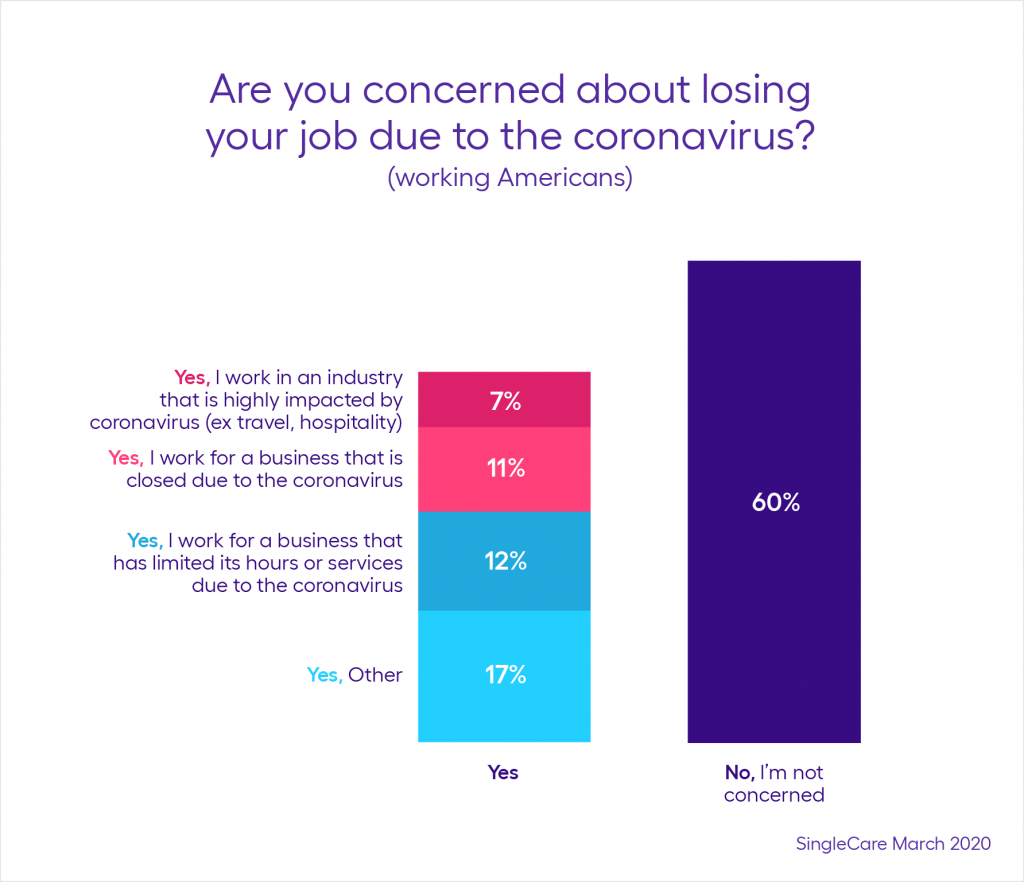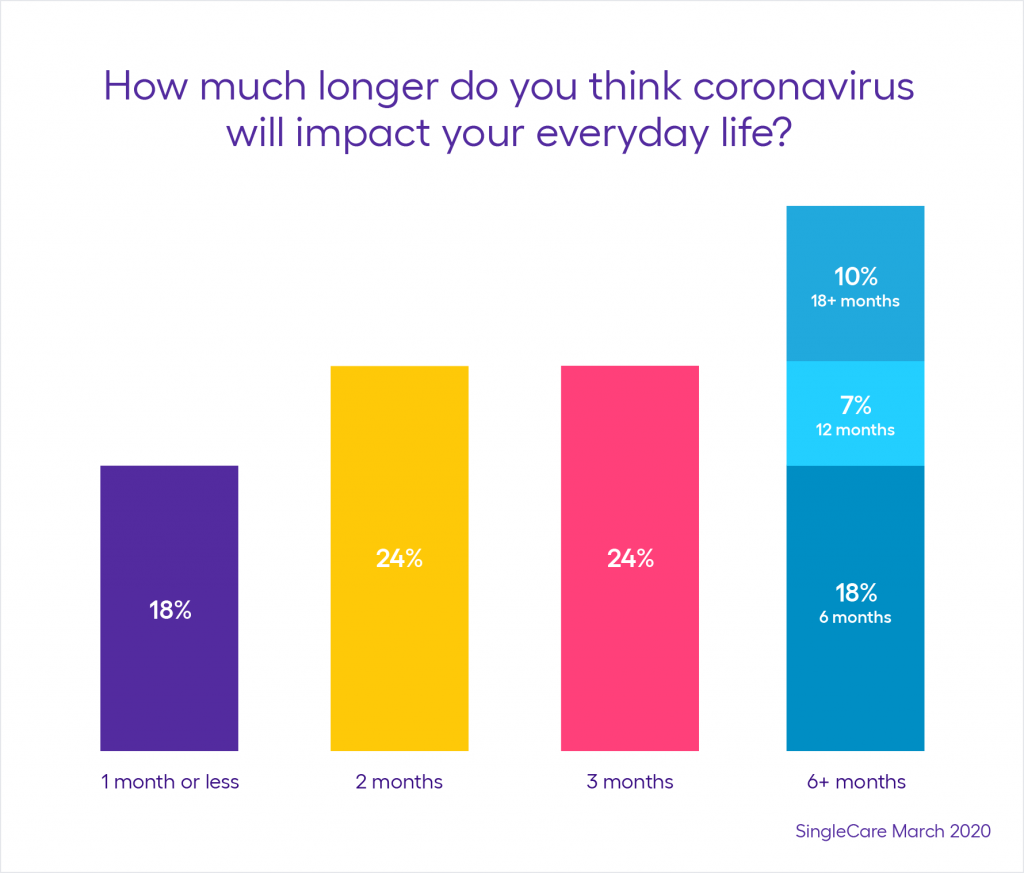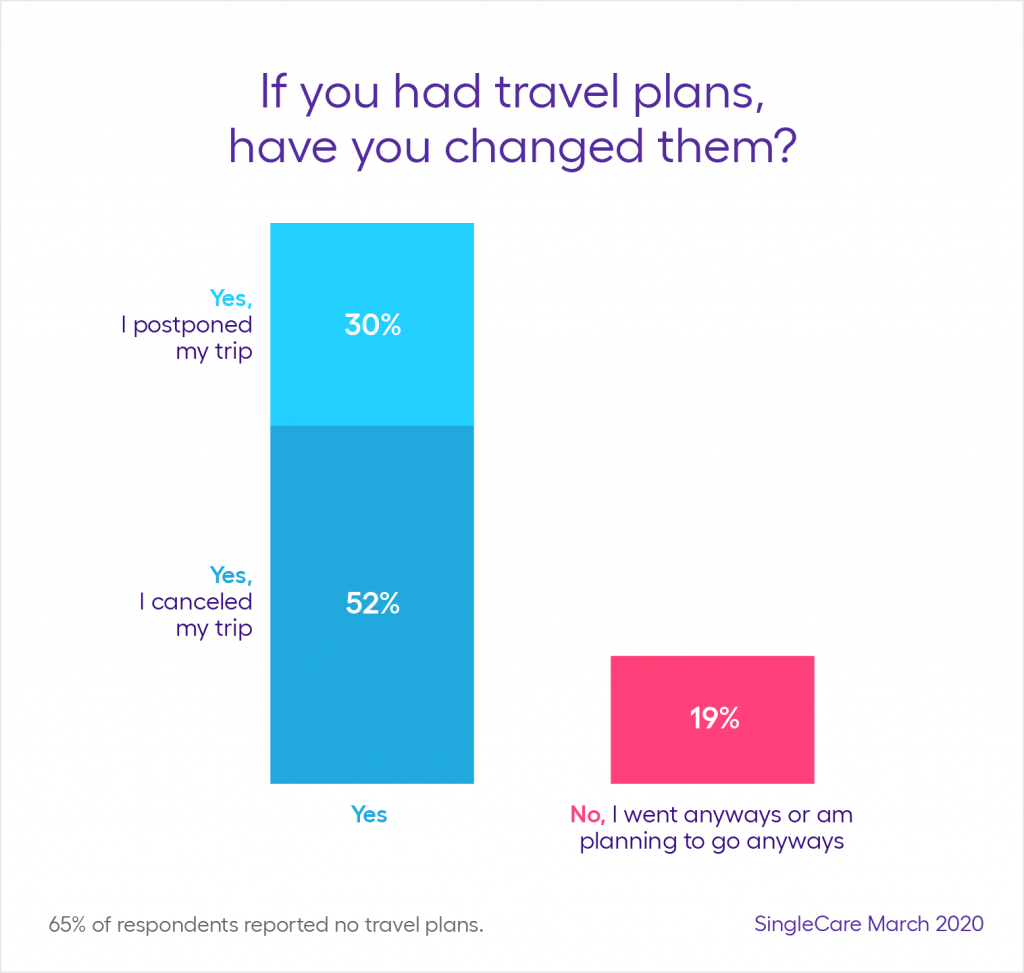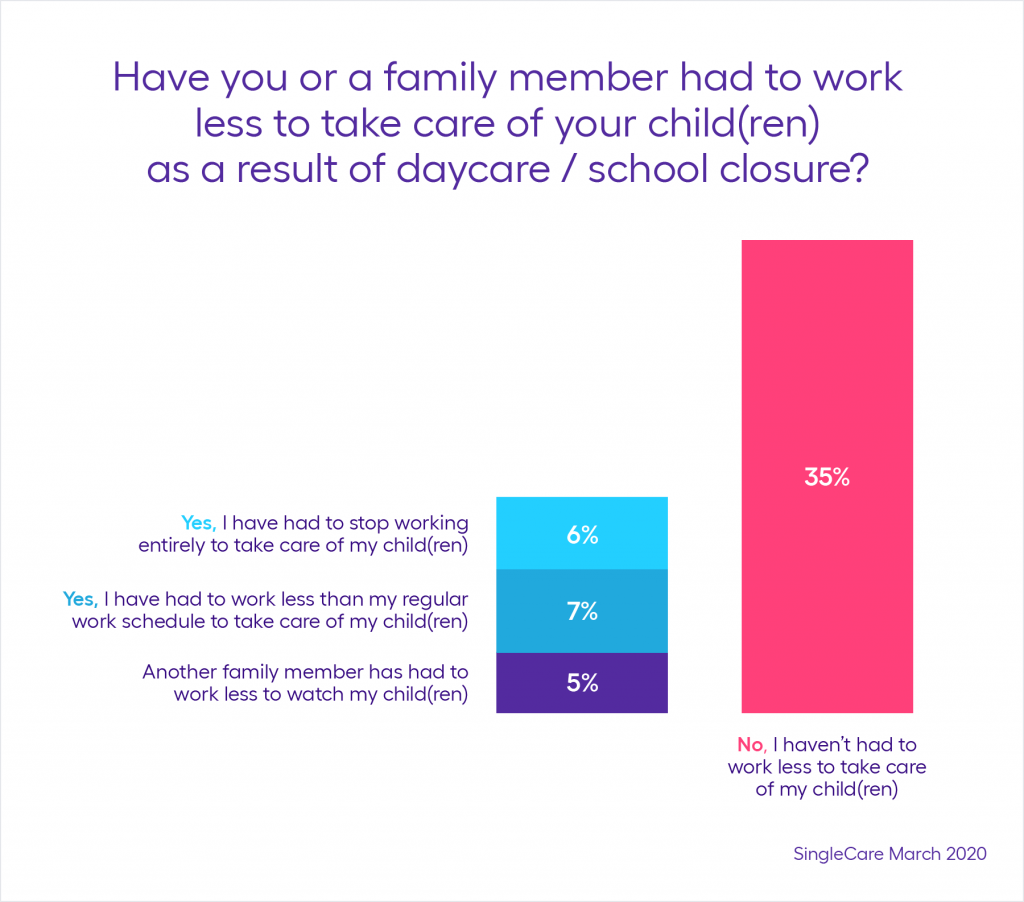The novel coronavirus has affected all 50 states in America. As part of our survey on coronavirus (COVID-19), we asked follow-up questions to find out how the pandemic has affected everyday life in the country so far, SingleCare surveyed 1,000 people living in the United States. Here’s what we found.
Summary of our findings:
- 74% of U.S. residents practice social distancing.
- 41% of working U.S. residents worry about losing their job.
- 35% of U.S. residents believe COVID-19 will impact their daily life for six months or longer.
- 29% of U.S. residents have canceled or postponed travel plans.
- 13% of parents have stopped working or are working less to care for their children.
Related: SingleCare’s Coronavirus / COVID-19 Information Station
74% of U.S. residents practice social distancing
Social distancing is today’s new buzzword. Social media feeds, the news, and even TV commercials are promoting social distancing as the best way to prevent coronavirus. In addition to keeping a public distance of at least 6 feet from others and avoiding social gatherings, we found the following:
- 65% avoid touching their face, nose, and eyes
- 62% practice home-isolation by voluntarily staying at home
- 59% limit visits to stores and pharmacies
- 28% adhere to government-mandated rules to shelter in place
- 19% change clothes upon returning home from the store and/or pharmacy
- 15% wear a face mask
- 14% started using contactless, mobile payments (e.g. Apple Pay, Google Pay)
This social distance has provided much more downtime. Here’s how people are spending their newfound free time:
- 60% are watching the news more
- 41% are using social media more
- 37% are using streaming services more
- 22% are doing more home improvements
- 22% are working out less
- 19% are drinking less alcohol
- 18% are having less sex
- 17% are eating more
41% of working U.S. residents worry about losing their job
Nearly half of working U.S. residents, and 29% of all U.S. residents, are concerned about losing their jobs due to the coronavirus outbreak. As “nonessential” businesses limit hours or close their doors altogether, more people worry that their job could be next.
State and local authorities have leeway in what they consider an essential business. In general, these industries include:
- Grocery stores
- Food and agriculture
- Pharmacies
- Healthcare providers
- Utilities (energy, water, telecommunications)
- Transportation and logistics
- Banking and financial services
- Community-based governmental services (security staff, educators, hotel workers)
- Law enforcement, first responders, and emergency personnel
Data from the U.S. Department of Labor shows that this worry may be warranted. There were 281,000 jobless claims for the week ending Mar. 14. While 5 million Americans were already working remotely before the coronavirus outbreak, working from home is not an option for the vast majority of U.S. workers. Fortunately, many corporations like Walmart, Amazon, and Starbucks are responding quickly and some are even on a hiring spree. Additionally, states like Colorado require employers to offer paid sick leave to service and hospitality workers. But still, some businesses might not rebound from a post-coronavirus economy with a prediction of 30% unemployment, which is higher than in the Great Depression (24.9%).

35% of U.S. residents believe COVID-19 will impact their daily life for 6 months or longer
The first COVID-19 case in the U.S. was confirmed more than two months ago, on Jan. 15. However, daily life for many Americans hadn’t been affected until two weeks ago when schools began to close, grocery store shelves emptied, and major cities were put on lockdown. It leaves people wondering, how much longer can this last?
Although the World Health Organization (WHO) warns that the coronavirus spread is accelerating around the world, perhaps we can look to China for more assurance as the number of new cases has started to decrease. The new virus originated in Wuhan of the Hubei province. Now, three months after the first known infected person was diagnosed, some Chinese residents have returned to work.
New cases in South Korea (first confirmed case on Jan. 20) and Italy (first confirmed case on Jan. 31) have also started to decline.
RELATED: Current COVID-19 treatments

29% of U.S. residents have canceled or postponed travel plans
29% of respondents have changed their travel plans. 30% of U.S. residents with travel plans have postponed their trip, but 52% of them have canceled altogether. Though sticking to flight schedules in order to keep their flight slots, most airlines have waived flight change fees and credited the accounts of travelers who have canceled their flights due to the virus.
Although 18% of people with travel plans noted that they have or are planning to travel despite the coronavirus outbreak, these plans may go awry as the travel industry takes a hit. Las Vegas casinos and hotels have suspended operations. Theaters, bowling alleys, malls, and museums have been closed across many states. Even North Carolina beaches have been shut down to discourage spring breakers from gathering. Health officials in many states have issued shelter-in-place orders with few exceptions for residents to leave their homes.
RELATED: Should you cancel your plans because of coronavirus?

13% of parents have stopped working or are working less to care for children
As of Mar. 20, 45 states have closed all public schools. At least 54.8 million students have been affected by closures due to the public health emergency, and their parents are scrambling to find childcare. Although some states like Ohio and Massachusetts have issued pandemic child care licenses or opened free childcare centers, many daycares have closed across the country.
With limited working hours and increasing layoffs, parents may not be able to afford childcare at this time. Many parents who once relied on grandparents as caretakers now fear that they’re putting the high-risk demographic at an even higher risk for coronavirus transmission.
The Centers for Disease Control and Prevention (CDC) reports that there is still limited information as to how COVID-19 affects children, but children do not appear to be at a higher risk than adults and confirmed coronavirus cases have mostly been mild. However, because carriers of the virus can be asymptomatic, community spread of the respiratory illness is possible and perhaps even likely in spaces with close contact like schools and daycares.
What’s more, two-thirds of students in the U.S. depend on free or reduced-price school lunches, according to the School Nutrition Association. District leaders fear that some children will go hungry while they’re out of school.
RELATED: What parents need to know about coronavirus in children

So, what now?
The new coronavirus has significantly affected everyday life in America and across the world. Sitting, waiting, and handwashing seem to be the next steps for Americans who have been ordered to shelter in place and practice social distancing.
Meanwhile, the U.S. government is taking action. President Trump signed a coronavirus relief bill into law last week, which includes provisions for free coronavirus testing, food assistance, and unemployment benefit expansions, and additional protections for healthcare workers. Another bill to fund national relief efforts, which is worth $1.4 trillion, is also in progress. Additionally, the National Guard will assist Washington State, California, and New York State in providing medical care.
Our methodology
SingleCare conducted this survey online through AYTM on March 20, 2020. This survey includes 1,000 U.S. residents adults ages 18+. Age and gender were census-balanced to match the population of the United States. Survey data can be downloaded here.
Research
- Guidance on the essential critical infrastructure workforce, CISA
- Latest work-at-home/telecommuting/mobile work/remote work statistics, Global Workplace Analytics
- Coronavirus: How employers around the globe are responding, SHRM
- Unemployment insurance weekly claims, Department of Labor
- Lockdowns, closures: How is each U.S. state handling coronavirus?, Aljazeera
- Expected U.S. macroeconomic performance during the pandemic adjustment period, Federal Reserve Bank of St. Louis
- Labor Force, Employment, and Unemployment, 1929-39, U.S. Bureau of Labor Statistics
- Map: Coronavirus and school closures, Education Week
- Guidance for school and childcare, CDC
- CoSN’s 2019 K-12 IT Leadership Survey Report, CoSN
- School meal trends and stats, School Nutrition Association
- Families First Coronavirus Response Act, U.S. Congress
- Coronavirus: Pandemic is ‘accelerating’, WHO warns as cases pass 300,000, BBC
Coronavirus resources
- Protecting your mental health while social distancing during the coronavirus outbreak
- Allergy vs. coronavirus symptoms: Which do I have?
- Coronavirus vaccine clinical trial to begin in U.S.
- Everything we know about Favilavir, the potential coronavirus treatment
- Coronavirus vs. the flu vs. a cold
- COVID-19 vs. SARS: Learn the differences




